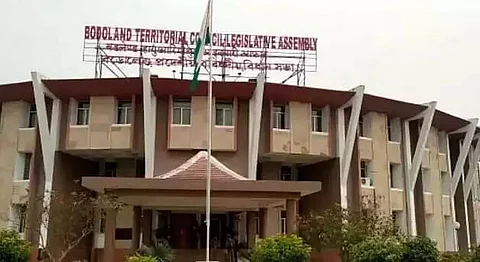
- Home
- Live Blog
- Breaking News
- Top Headlines
- Cities
- NE News
- Sentinel Media
- Sports
- Education
- Jobs

Lack of clarity in land policies have made the issue of
protection of Tribal belts and blocks in Assam more complicated than before.
The Assam Land Policy, 2019 clearly states that all provisions of Chapter -X of
the Assam Land and Revenue Regulation Act, 1886 shall be followed scrupulously
including removal of non-eligible persons from Protected Belt and Block Area.
The clause 17.2 of the policy approved by the State Cabinet also states that
the Deputy Commissioners shall take utmost care while granting permission for
transfer of land within protected Belts/Blocks and that they should see that no
non-eligible person gets permission of acquiring land within protected
Belt/Block. The land policy has also spelt out clear direction to the Deputy
Commissioners concerned that in case of transfer of land to registered
cooperative society/firms/companies etc., it must be ensured that all the
members including the office-bearers belonging to protected class of people
notified by the government. The clause 4.3 of the Bodo Accord of 2003 that led
to creation of the Bodoland Territorial Council, on the other hand, promises
that any such law as may be made by the BTC will not "extinguish the rights and
privileges enjoyed by any citizen of India in respect of his land at the
commencement of the BTC, and bar any citizen from acquiring land either by way
of inheritance, allotment, settlement or by way of transfer if such citizens
were eligible for such bonafide acquisition of land within the BTC area.
The accord also promises that the amendments to the Sixth Schedule shall include provisions in such a manner that non-tribals are not disadvantaged in relation to the rights enjoyed by them at the commencement of BTC and their rights and privileges including land rights are fully protected. The land policy-2019 of the State government, however, has not mentioned anything in regard to the Protected Belt/Block within the jurisdiction of the BTC as land is one of the 40 subjects transferred to the BTC authorities by the State government under the amended provisions of the Sixth Schedule. The BTC has not notified any new class of people for the purpose of implementation of the clause 4.3 in respect of the tribal Belt and Blocks in Bodoland Territorial Region (erstwhile Bodoland Territorial Area District) comprising the four districts of Kokrajhar, Chirang, Baksa and Udalguri. Hence, for legal purpose of land transfer the notified classes of people are the same as in other tribal belts and blocks outside the BTR. Initially the "plain tribal, hill tribal, tea garden tribal, Santhals, Nepali cultivator-graziers and Scheduled Castes" were notified on December 5, 1947 as classes of people entitled to protection under Section 160 of the Assam Land and Revenue Regulation, 1886. Subsequently, the Nepali cultivator-graziers were excluded from protected classes on June 27, 1969 while Koch-Rajbongshis of Dhubri, Kokrajhar and Goalpara district were included in the list of protected classes on April 29, 1985. However, subsequent to signing of the Bodo Accord, no new classes of people were added to the list to reflect the Clause 4.3 of the Accord.
This explains the ambiguity in protection of the tribal belt and block in BTR areas and rest of Assam. Even though the BTC authorities promise protection of land rights of non-tribal people in BTR who have been living there prior to 2003, the courts for the purpose of deciding legal question pertaining to protection of tribal belt and block has to refer to existing land laws and certainly not the promises by leaders which have no legal basis. The ambiguity will hinder permanent peace in BTR. Unchecked encroachment of tribal belts and blocks by non-notified classes of people will continue to grip the notified classes of people with the apprehension of existential threat to their identities while denial of land rights to eligible non-tribal people contrary to promises made in Bodo accords will keep alive the apprehension of eviction among them. About 3.85 lakh bighas of land in tribal belts and blocks in BTR are under encroachment of non-protected people. The ambiguity over the legal question of whether it is the State government or the local authorities in a Sixth Schedule area that has the absolute right to settle land in areas under the autonomous councils also needs be clarified. Land is a sensitive issue and unsettled questions of land rights keep the Faultline of competing identities alive, which in turn, make peace fragile in areas like BTR. Solutions to such sensitive issues cannot be reduced to election promises. Only a comprehensive land policy for BTR with clear answer to these questions can end the complexities gripping both implementation of the Chapter X for protection of tribal belt and blocks as well as protection of land rights of non-tribal people living in BTR.